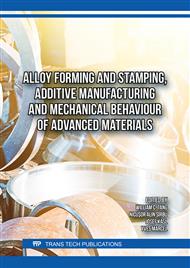[1]
Xu, G., & Hu, J. (2023). "Research on Ultrasonic Welding Technology for Dissimilar Metals in Automotive Applications." Materials Science Forum, 1069, 172-179
Google Scholar
[2]
Kumar, A., & Bhattacharya, A. (2023). "A review on ultrasonic welding of dissimilar metals for automotive applications." Materials Today: Proceedings, 70, 90-95
DOI: 10.1016/j.matpr.2022.11.115
Google Scholar
[3]
Kumar, M., & Dey, S. (2022). "Investigation of ultrasonic welding of dissimilar materials: A review." Journal of Manufacturing Processes, 70, 217-233
DOI: 10.1016/j.jmapro.2021.11.019
Google Scholar
[4]
Wang, Y., et al. (2022). "Advancements in Ultrasonic Welding of Dissimilar Metals: Applications in Automotive Industry." Journal of Materials Processing Technology, 301, 117470
DOI: 10.1016/j.jmatprotec.2021.117470
Google Scholar
[5]
Zhou, Y., & Jiang, Y. (2022). "Effects of ultrasonic welding parameters on the joint properties of dissimilar metals." Journal of Alloys and Compounds, 895, 162477
DOI: 10.1016/j.jallcom.2021.162477
Google Scholar
[6]
Sharma, P., & Gupta, M. (2022). "Ultrasonic welding of aluminum to copper: A review." Materials Today: Proceedings, 45, 4898-4902
DOI: 10.1016/j.matpr.2020.05.176
Google Scholar
[7]
Lee, H., et al. (2021). "Optimization of ultrasonic welding parameters for dissimilar metals in automotive applications." The International Journal of Advanced Manufacturing Technology, 113, 1547-1556
Google Scholar
[8]
Li, J., & Zhao, J. (2021). "Characterization of joint properties in ultrasonic welding of dissimilar metals." Welding in the World, 65(1), 129-136
Google Scholar
[9]
Rathore, S., & Kaur, S. (2021). "Ultrasonic welding of aluminum and copper: A comprehensive review." Materials Today: Proceedings, 37, 2078-2083
DOI: 10.1016/j.matpr.2020.10.329
Google Scholar
[10]
Kim, Y., & Park, J. (2021). "Effect of welding parameters on the microstructure and mechanical properties of dissimilar metal joints." Journal of Materials Science, 56(4), 2941-2950
DOI: 10.1007/s10853-020-05135-y
Google Scholar
[11]
Sang, W., et al. (2020). "Investigations on ultrasonic welding of dissimilar metals for automotive applications." Materials & Design, 192, 108740
DOI: 10.1016/j.matdes.2020.108740
Google Scholar
[12]
Mizukami, H., & Yamamoto, Y. (2020). "Microstructural evolution and mechanical properties of ultrasonic welded joints of aluminum and copper." Metals, 10(3), 335
DOI: 10.3390/met10030335
Google Scholar
[13]
Marques, C.,& Costa, J. (2019). "Ultrasonic welding of dissimilar metals: Recent advances and challenges." Materials Science and Engineering: A, 746, 100-112
DOI: 10.1016/j.msea.2018.12.065
Google Scholar
[14]
Gupta, N., & Shukla, R. (2019). "Ultrasonic welding of aluminum and copper: Process optimization and joint characterization." Welding Journal, 98(4), 129-136
Google Scholar
[15]
Sun, Y., et al. (2018). "Research progress in ultrasonic welding of dissimilar metals." Journal of Materials Research and Technology, 7(1), 51-60
DOI: 10.1016/j.jmrt.2017.09.002
Google Scholar
[16]
Qin, J., & Li, X. (2018). "Effects of ultrasonic welding parameters on the mechanical properties of aluminum/copper joints." Materials Chemistry and Physics, 215, 176-183
DOI: 10.1016/j.matchemphys.2018.04.023
Google Scholar
[17]
Zhang, L., & Liu, Z. (2018). "Dissimilar metal joining technologies: Ultrasonic welding and its applications." The International Journal of Advanced Manufacturing Technology, 94(1-4), 779-788
Google Scholar
[18]
Cai, Y., et al. (2017). "Study on ultrasonic welding of aluminum/copper dissimilar materials." Journal of Alloys and Compounds, 695, 1631-1637
DOI: 10.1016/j.jallcom.2016.10.052
Google Scholar
[19]
Chen, H., et al. (2017). "A review on ultrasonic welding of dissimilar materials." Journal of Materials Processing Technology, 242, 245-259
DOI: 10.1016/j.jmatprotec.2016.12.004
Google Scholar
[20]
Guo, Y., et al. (2017). "Ultrasonic welding of dissimilar metals: State-of-the-art and future trends." Advanced Materials Research, 904, 126-131. doi:10.4028/www.scientific.net/ AMR.904.126
Google Scholar
[21]
Ullah, M., et al. (2016). "Effect of welding parameters on microstructure and mechanical properties of aluminum-copper joints." Journal of Materials Science & Technology, 32(6), 559-564
DOI: 10.1016/j.jmst.2016.03.009
Google Scholar


